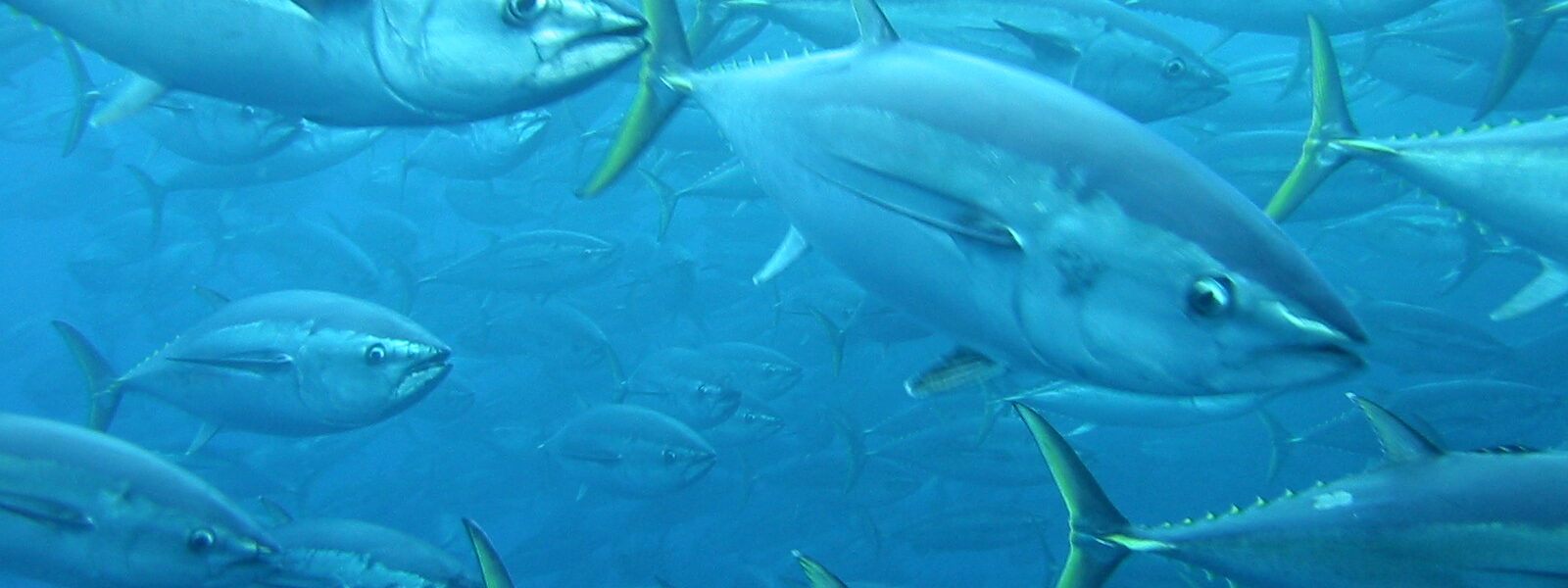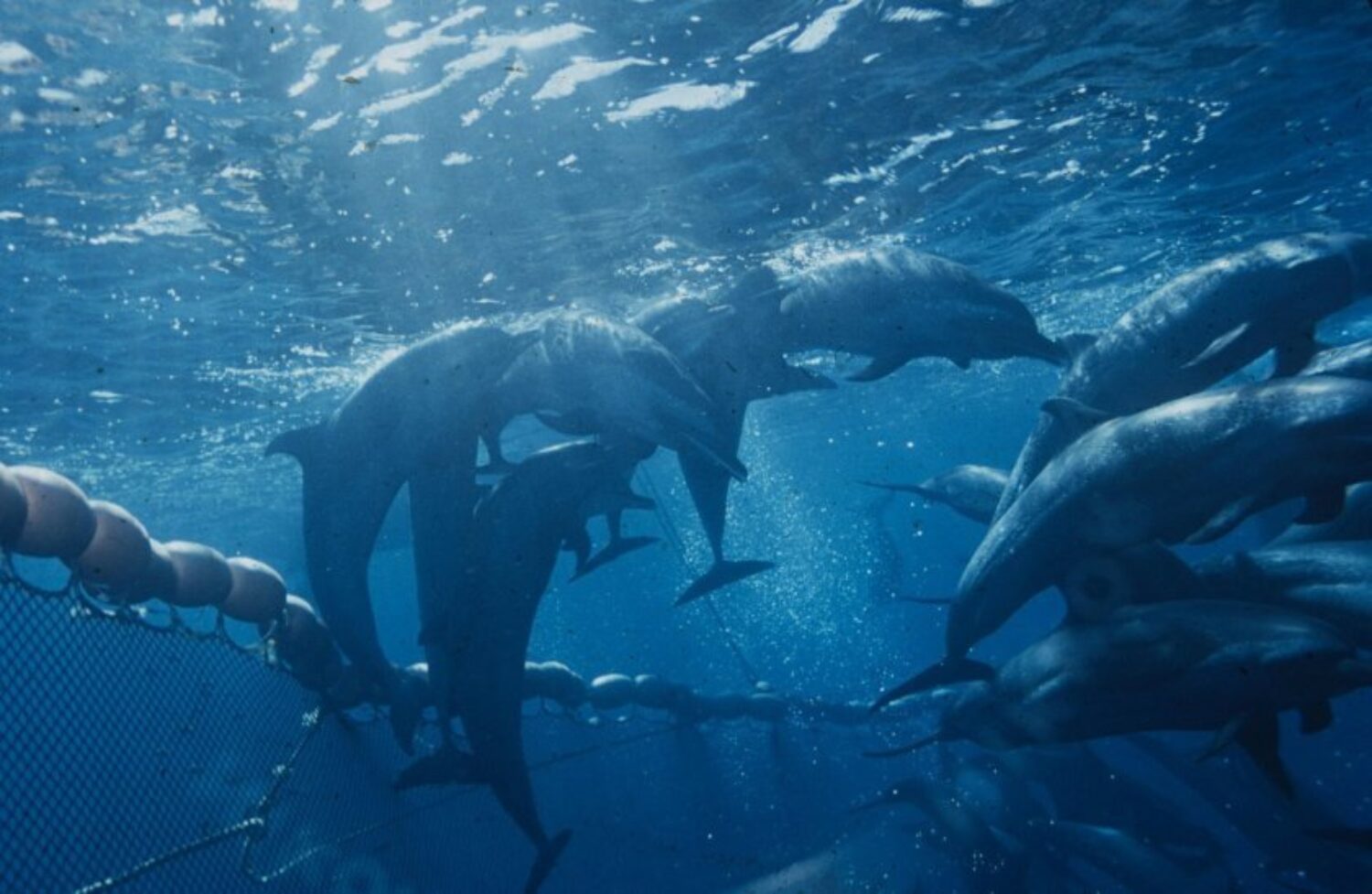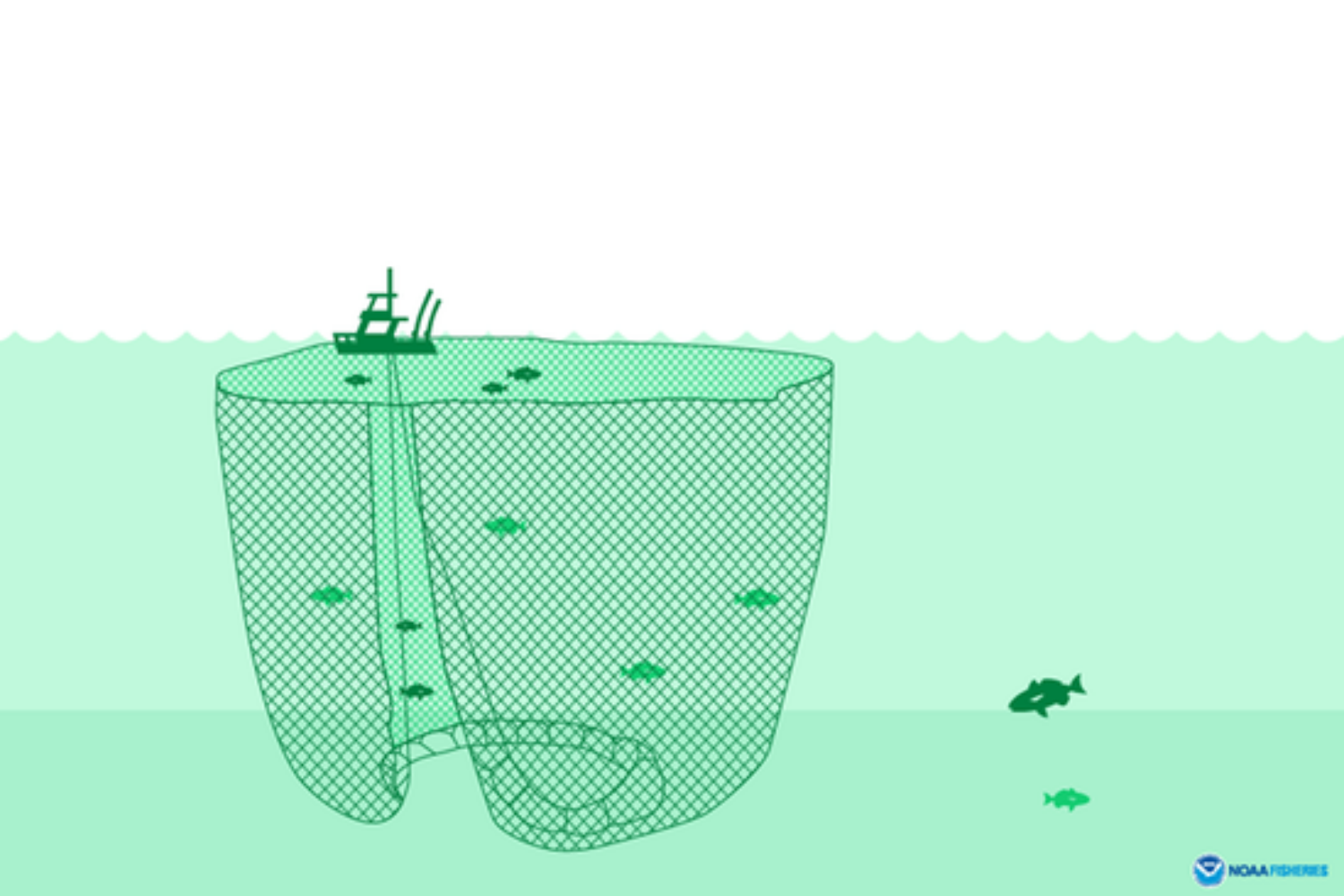
The Tuna Dolphin Tragedy
Research & Writing by Fiona Mulhern
The Dolphin Safe Standards Have Cut Dolphin Deaths by Thousands, but Some Nations Continue to Chase, Net and Kill Dolphins to Catch Tuna.
Fiona Mulhern is an intern with the International Marine Mammal Project (IMMP) of Earth Island Institute, researching and writing about plastics issues and marine mammals. She holds a BS from Santa Clara University, and is currently an intern at the University of California Santa Cruz’s Joseph M. Long Marine Laboratory.
Along the western coast of the Americas, dolphin species are often followed by yellowfin tuna – a rare relationship seldom observed in other oceans. Fishers purposefully search for dolphins by sea and by aircraft, then will chase the dolphins by speedboat and lay out a mile-long wall of netting that captures tuna and drowns whole pods of dolphins – a brutal method that has killed more than seven million dolphins in the Eastern Tropical Pacific since the late 1950s.
A campaign led by IMMP in the 1980s resulted in the Dolphin Safe tuna label, which has slashed dolphin deaths dramatically, but can deadly Mexican, Venezuelan, and Colombian fishing fleets be pressured into adopting the same standards?
The Eastern Tropical Pacific Ocean (ETP), located along the coast of the Americas stretching from northern Peru to southern California, is considered one of the most productive oceans in the world. The ETP is home to large amounts of yellowfin tuna (Thunnus albacares), sought after by purse-seine tuna fishing vessels. These tuna are often found swimming beneath schools of Pantropical spinner (Stenella attenuata), spotted (Stenella longirostris), and common dolphins (Delphinus delphis and Delphinus capensis). This tuna-dolphin relationship is only found throughout the ETP on a regular basis and is very rare in other oceans, and scientists have not yet been able to explain this ecological phenomenon.

Spotted dolphins (Stenella attenuata) encircled in a tuna purse seine net in the Eastern Tropical Pacific Ocean. Dolphins need to reach the surface in order to breathe, and when they are caught in tuna nets, they can drown or be seriously injured. (Photo Credit: National Marine Fisheries Service/Southwest Fisheries Science Center)
If humans continue on our current track, scientists may not have the chance to uncover the tuna-dolphin relationship before it’s too late. In the ETP, fishers purposefully seek out dolphin schools to find tuna. The intensive search for dolphins is conducted in helicopters, fixed wing aircraft, or crow’s nests on purse seine vessels. From the mother ship, fishers send small speedboats to circle and chase the dolphins until they are exhausted. The mother ship then deploys purse-seine netting around the dolphins, a mile-long wall of plastic netting that can capture entire schools of fish at once, leaving no path for marine mammals to escape.
There is nothing accidental about the deliberate netting of pods of dolphins in this tuna fishery. Dolphins often die because of stress, injuries, drowning in the mesh, the sheer weight of the catch on top of them, or the impact of landing on the fishing vessel.

Diagram of purse-seine fishing, a common practice in the Eastern Tropical Pacific by fishers who do not follow Dolphin Safe fishing techniques but instead deliberately target and encircle pods of dolphins. Once a pod of dolphins is located, they are encircled with the net. The lead line at the bottom is then pulled in, "pursing" the net closed, preventing fish from escaping by swimming downward. Purse seines deliberately encircle marine mammals along with the tuna that swim beneath as the net is set. (Image Credit: National Marine Fisheries Service)
History of the Tuna/Dolphin Tragedy
Dolphins have been drowning at an alarming rate for more than half a century. By 1970, scientists estimated that 200,000 to 300,000 dolphins died each year in the ETP tuna fishery. US tuna fleets were responsible for the majority of deaths at that time, in part compelling the U.S. to pass the Marine Mammal Protection Act (MMPA) of 1972. The MMPA prohibited the killing, harassment and capture of marine mammals without a permit and required US tuna fishers in the ETP to reduce dolphin deaths “to levels approaching zero.”
In response, US tuna fishers developed the “back-down technique” – which included an alternative purse-seine net design that helped avoid killing dolphins. The net had finer mesh at the surface to avoid snagging dolphins by their beaks and fins, and a maneuver called “backing down” dropped the net slightly at the surface, allowing trapped dolphins to swim out while tuna deeper down in the net remained. This technique was a good start to solving the crisis at hand, but required skilled boat operators to work. Also, despite a dramatic decrease in dolphin deaths, the technique still killed too many dolphins. This method of fishing is not considered “Dolphin Safe” by most conservationists and tuna companies.
In the 1980s, Mexico and other ETP countries built up tuna fleets but made no effort to reduce dolphin catch with the back-down technique. Despite the efforts of US fishers, dolphin deaths began to increase. Towards the end of the 1980s, with 80,000 to 100,000 dolphin deaths each year caused by the US and international tuna fleets combined, it was clear that the MMPA and other legislation were not providing dolphins adequate protection.
In 1987, the International Marine Mammal Project (IMMP) of Earth Island Institute began a major campaign to end the killing of dolphins in tuna nets. In 1988, biologist Samuel LaBudde went undercover on a Panamanian tuna fishing boat in the ETP to get a first-hand understanding of the mass dolphin mortalities. LaBudde collected video footage with help from the Marine Mammal Fund and IMMP. He was the first person to have video proof of the dolphin slaughter. LaBudde’s video made national television news, sparking both public outcry at the horror and demands for a solution.
The Dolphin Safe Tuna Label
In 1990, the uproar caused by biologist Samuel LaBudde’s under-cover video and the campaign generated by IMMP, led to the creation of the Dolphin Safe tuna label in the US. IMMP, in cooperation with US tuna companies, defined Dolphin Safe tuna as “caught without setting nets on or near dolphins.” The label is prohibited for any tuna that was caught while intentionally chasing or netting dolphins. IMMP’s campaign led to the incorporation of this standard, via the Dolphin Protection Consumer Information Act, into the Marine Mammal Protection Act (MMPA) in 1990. To date, more than 800 tuna companies, about 95% of the global tuna industry, have pledged to fish in a Dolphin Safe manner. IMMP monitors around the world check tuna supplies, canneries, records, and freezer units to help ensure compliance.
New MMPA amendments in 1997 clarified that if a net contained accidental dolphin mortalities or serious injuries, a fairly rare event if the tuna vessel is not targeting dolphins, the landed tuna could not be labeled Dolphin Safe in the US. Subsequent legislation also banned the import of tuna to the U.S. from international fleets that fished in the ETP unless those countries also adopted Dolphin Safe fishing practices, but those provisions were weakened in the 1997 law.
The Dolphin Safe tuna label has been a huge success. Since the creation of the label, onboard government observers have recorded sharp decreases in dolphin deaths by US and most foreign tuna vessels. These advances made by Dolphin Safe tuna fleets have not been matched by the fleets of Mexico, Venezuela and Colombia, however, which continue to chase and net dolphins. In 1989, the year before the Dolphin Safe tuna label, an estimated 100,000 dolphins were killed in the ETP. In 2020, the reported number of deaths totaled just 689, based on government observer counts, and none of the deaths were linked to US vessels.
Damage to Dolphin Populations
While the Dolphin Safe tuna label has slashed dolphin deaths in the ETP, population-wide damage persists from decades of poor fishing practices. Several dolphin populations have been listed as “depleted” under the MMPA standards. These populations have not recovered to original levels.
The effects of such fisheries extend beyond just the captured individual dolphins. Several studies have found nearly twice as many lactating female dolphins as calves in each catch, indicating that mothers are separated from their calves during the chase and net deployment. Orphaned dolphin calves, left behind, are especially vulnerable to predation and starvation. Death of calves is not included in the number of dolphins observed killed in nets, reducing population levels even further.
IMMP and our allies continue to press for more companies to join our Dolphin Safe program and adopt policies to avoid harming dolphins and other marine life. You can learn more about Dolphin Safe tuna, IMMP’s campaign, and a list of companies that have pledged to fish in a Dolphin Safe manner on our website.
We’ve also posted a FAQ about the tuna/dolphin issue.
******************************
